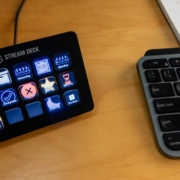Single Threading
Except for the contexts of my high school students’ minds and technology, I am probably too young to be considered old. However, when it comes to personal computers, I am something along the lines of an Ent.
The first computer I have memories of using had a single 75 MHz processor. An iPhone 12 has (essentially) six processors in it, which total (at least) 13,400 MHz of proceeding speed.
My formative years using a computer were colored by having to choose the one thing I wanted to do with my computer, which on that computer was usually the MindMaze game in Microsoft Encarta.
Single Threading Definition
I know multitasking has existed long before fast computers became commonplace, but I can’t help but imagine a connection. We deal with incredible devices all day that can simultaneously play music, stitch together a video of your recent photos, update software, and have a pointless Teams meeting muted in the background while you respond to some emails. Our devices have multiple means of working on several tasks at once. One word for this is multithreading.
It’s hard to believe that our brains can’t do the same thing. Our brains can only do one cognitive task at a time.

Yes, you can walk and chew gum at the same time. You can even walk and plan out a blog post at the same time. If you are exceptionally skilled, you might even be able to walk, chew gum, and think! However, try to write a blog post about single threading and do your taxes simultaneously. Things are going to fall apart and quick. If you don’t want to get audited, I would encourage you to single-thread these tasks instead.
All current evidence points to the fact that the biology of your brain just can’t do multiple cognitive tasks at once. Instead, your brain quickly switches from one task to another and back again. This is a biologically costly process. Not only does your brain need more physical resources to do this, but it is also going to be slower at completing both tasks at once than it would be if it did one task to completion and then switched to the second.
Single threading is the deliberate decision to focus on completing one cognitive task at a time until a discrete unit of progress is achieved.
Single Threading Analogy
Think of your brain like a river and your productivity as a boat you are rowing. If you plan your tasks well and focus on one at a time, you are essentially paddling downstream. The flow of the river magnifies your energy, and you make more progress faster. This is single threading.
If you plan poorly or outside forces ruin your day, you have to zig-zag across the river or even battle your way upstream. Incredible energy is expended, and little progress is made. This is multithreading.

Single Threading Experiment
With analogies and definitions out of the way, let’s do an experiment to demonstrate this concept. You will need a pencil and a piece of paper to complete the test. Follow along with the video below:
Single Threading Podcast Episode
If you are a podcast fan or know someone who is, this episode of Note to Self is a great introduction. I share it with my students at the beginning of the year, and every year multiple students tell me (months after listening to the podcast) that it still impacts their life.
Deep Work
Those little chunks of time from the experiment above add up. So do the effort and biological resources of your brain. If you regularly apply this concept of single-threading to your life, you will notice a cumulative effect on your work and brain that Cal Newport best describes in this video:
Strategies For Implementation
So if you are still reading, I will assume that you are ready to try to do this in your life. I am happy to share some sustainable ways I have implemented single threading into my work and home.
Emails Rules
I wrote a post called Sanity Saving Email Rules, which I recommend as a starting point to anyone who has a work email. This simple act probably has the highest return on investment for the time it takes vs. the attention it saves. 100% this is the first thing you should do.
Pomodoro Timer
After taking a week to automate the taming of your work email, you should start being deliberate on what you do with that newly saved attention. The Pomodoro Method is a wonderful way to start being intentional about your time and attention. The 25-minute time commitment is small enough to fit into any schedule and requires nothing more than a timer and a task. I made a video about the Pomodoro timer I created and use to this day:
Fake Multithreading
While you can not do more than one cognitive task at a time, the urge to try is so tempting that you might benefit from faking your brain into feeling like you are. I satiate that desire by using the machines in my life. If I have a load of towels in the dryer and dishes going in the dishwasher while I am writing this post, I feel incredibly productive.
Automating Processes
Once I got in the habit of single threading, I realized that many of my tasks have standard procedures. Unfortunately, many of those procedures would take more than a 25-minute Pomodoro timer; until I started automating the boring parts! The process of writing a letter of recommendation is a great example. What used to take two Pomodoro sessions is now one because I automated the heck out of it. Now I can focus on writing the letter in 25 minutes and call it a day; the automations take care of the rest.
Conclusion
There is an excellent quote from the late Anthony Bourdain:
I understand there’s a guy inside me who wants to lay in bed, smoke weed all day, and watch cartoons and old movies. My whole life is a series of stratagems to avoid, and outwit, that guy.
Anthony Bourdain
My distractors are different from his, but the sentiment resonates in my bones. I label it single threading instead of single-tasking because the computer science version’s absolute structure helps me remember I can’t overpower this part of my brain. This post is not about how organized I am or how under control I have things. It is about knowing my limitations and just how easy it is to give in to the temptations to play video games or binge-watch a show.
I hope this post gave you some strategies to outwit the lazy version of you!












Leave a Reply
Want to join the discussion?Feel free to contribute!